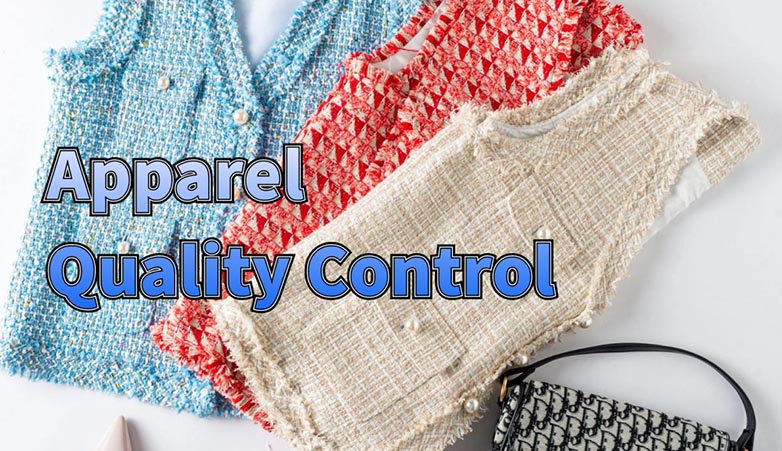
Quality control is the cornerstone of successful garment manufacturing. It ensures that products meet customer expectations, adhere to industry standards, and minimize waste and defects. Common challenges faced by manufacturers include inconsistent material quality, inefficient processes, and maintaining consistency of standards across diverse production environments.

1. Establish clear quality standards
Firstly, it is necessary to clarify the quality expectations for both materials and finished products.
During the production process, manufacturers must establish a series of clear, specific, and measurable quality benchmarks for the raw materials used, including but not limited to various fabrics, accessories, etc., as well as the final finished garments. The establishment of these benchmarks ensures consistency and compliance of the products throughout the entire production chain, guaranteeing stable product quality.
Secondly, integrate industry standards into the quality management system.
Manufacturers should actively respond to and strictly adhere to internationally recognized quality management standards, such as the ISO 9001 quality management system standard, as well as relevant standards like the Acceptable Quality Level (AQL). By adhering to these industry benchmarks, manufacturers can effectively enhance their quality management capabilities, maintain strong competitiveness in the global market, ensure that their products comply with regulatory requirements in various countries, and reduce potential market risks.
Finally, ensure that the quality standards are closely aligned with customer needs.
Manufacturers need to deeply understand and fully integrate customers' specific demands for product quality. This aspect is crucial for establishing and maintaining customer satisfaction and loyalty. By maintaining close communication with customers, promptly capturing and responding to changes in their quality expectations, manufacturers can continuously optimize product quality, meet or even exceed customer expectations, and win widespread recognition and trust in the market.
2. Conduct a comprehensive material inspection
To ensure product quality and customer satisfaction, a series of detailed and rigorous tests need to be conducted on fabrics and accessories.
Firstly, comprehensive testing is conducted on the strength, shrinkage rate, and color fastness of the fabric. The testing of fabric strength is used to verify its durability in daily use, ensuring that the clothing can withstand various wear and tear and maintain its integrity for a long time.
Meanwhile, shrinkage testing ensures that the fabric maintains its appropriate size after washing, preventing issues such as garment deformation or ill-fitting caused by shrinkage.
In addition, color fastness testing is crucial, as it effectively evaluates the colorfastness of fabrics, ensuring that the colors of clothing remain vibrant after prolonged wear and multiple washes, meeting consumers' dual demands for aesthetics and practicality.
Besides the fabric itself, we also place equal emphasis on the quality verification of accessories and components.
Zippers, buttons, and other components are indispensable to clothing, and their quality directly affects the overall user experience and durability of the product.
Therefore, it is necessary to conduct a meticulous inspection of every accessory and component to ensure that they not only meet the quality standards within the industry, but also fulfill our stringent requirements for safety performance.
Through such comprehensive material inspection, we strive to provide consumers with high-quality products that are both aesthetically pleasing and practical, durable, and safe.
3. Implement a multi-stage quality control process
Implementing a multi-stage quality control process is a crucial step in ensuring product quality, enhancing customer satisfaction, and safeguarding the reputation of the enterprise.
The process covers everything from preparation before production to final inspection before shipment, with each step being crucial and collectively forming a rigorous quality control system.
Firstly, pre-production inspection is the starting point of the quality control process.
At this stage, we conduct a comprehensive inspection and evaluation of the materials and samples used. Through early inspection, we can ensure that the materials and samples fully meet the design and quality requirements, laying a solid foundation for subsequent large-scale production. This step helps prevent potential quality issues, and also allows us to identify and address possible material defects or non-conformities in advance, avoiding unnecessary waste and delays during the production process.
Next, inspection during the production process is a crucial step to ensure product quality.
We will implement regular inspections and monitoring at various stages of production to promptly identify and address potential defects and issues that may arise during the production process. Through this stage of inspection, we can quickly identify and correct deviations in the production process, ensuring that products are produced in accordance with established standards and specifications. This not only helps to improve production efficiency but also reduces waste and delays caused by quality issues, reduces costs, and enhances overall production efficiency.
Finally, the final inspection before shipment is the concluding step of the quality control process and an important step to ensure that the products meet all quality standards before being delivered to customers.
At this stage, we conduct a comprehensive evaluation and inspection of the finished products, covering multiple aspects such as appearance, performance, and functionality. Through rigorous final inspection, we can ensure that every product meets or exceeds customer expectations and requirements, thereby earning customer trust and satisfaction. This step not only helps enhance the market competitiveness of our products but also establishes a positive brand image and reputation for our company.
Implementing a multi-stage quality control process is a crucial guarantee for ensuring product quality, enhancing customer satisfaction, and safeguarding corporate reputation. We will continue to uphold the rigorous and meticulous quality control philosophy, continuously improve and optimize our quality control processes, and provide customers with higher quality and more reliable products and services.
4. Utilize advanced testing methods
To ensure the superior quality and compliance of our clothing products, our laboratory employs advanced testing methods to conduct comprehensive and meticulous evaluations of the durability and safety of clothing under various complex conditions. These tests strictly adhere to international regulations and standards, ensuring that every garment meets the highest requirements within the industry.
In terms of durability testing, it is necessary to attempt simulating various wear and tear scenarios that clothing may encounter in daily use, such as stretching, friction, and washing. Through comprehensive testing using professional equipment, the fabric, stitching, and accessories of the clothing can be thoroughly examined. This approach enables an accurate assessment of the clothing's durability, ensuring that it maintains good condition even after prolonged use.
Meanwhile, in terms of safety testing, special attention should be paid to the impact of clothing on human health. By examining indicators such as the content of harmful substances in clothing, skin irritation, and flame retardancy, we can ensure that clothing poses no potential harm to the human body during wear.
In addition, professional performance testing is required for clothing tailored for specific purposes. Whether it's sportswear or outdoor clothing, a series of professional tests are conducted to evaluate its performance in specific environments. For instance, for sportswear, tests are conducted on its breathability, moisture absorption, and elasticity to ensure that athletes can maintain comfort during intense exercise. For outdoor clothing, emphasis is placed on testing its waterproofing, wind resistance, and warmth retention to ensure that wearers can be fully protected even under harsh weather conditions.
Through these advanced laboratory testing methods, we can ensure that every piece of clothing possesses excellent durability and safety, meeting the expectations and needs of consumers.
5. Build a professional quality control team
To build an efficient and professional quality control team, it is crucial to understand the importance of training employees in inspection techniques. Therefore, regular training courses are arranged for quality control personnel to ensure that they can keep pace with industry developments and master the latest inspection methods and industry standards. These training courses cover theoretical knowledge and also incorporate practical case studies, allowing quality control personnel to continuously enhance their professional skills and inspection proficiency through practical application.
At the same time, we must also focus on promoting consistent communication among departments. Establishing an effective communication mechanism between the production, design, and quality teams is crucial to ensuring product quality. Through regular meetings, work reports, and cross-departmental collaboration, we can keep abreast of the work progress and existing issues of all parties, jointly discuss solutions, and ensure consistency in quality objectives throughout all stages of the production process. Close interdepartmental cooperation not only improves work efficiency but also effectively enhances the overall quality of products, laying a solid foundation for the sustainable development of the enterprise.
6. Utilize technology to enhance quality control
In today's era of rapid technological advancement, we are fully aware of the importance of technology in enhancing quality control.
Automated inspection tools and software
Actively introduce automated inspection tools and software to facilitate a comprehensive upgrade of quality control work. These automated inspection systems and AI-based tools, with their high intelligence and precision, greatly enhance the accuracy and efficiency of quality assessment. They can swiftly identify potential issues in products and provide timely and accurate feedback to quality control personnel, thereby ensuring that every product meets high-standard quality requirements.
Data-driven method tracks quality metrics
We also adopt a data-driven approach to track and analyze quality metrics. Through in-depth mining and analysis of quality data, we can clearly identify trends in quality changes and promptly detect potential quality issues. These data not only provide us with a basis for optimizing the quality control process but also help us effectively prevent the occurrence of repetitive problems. Through data-driven decision-making, we can manage quality control work more scientifically and continuously improve product quality and competitiveness.
END
Effective quality control practices establish customer trust, enhance brand reputation, and drive long-term success. Investing in robust quality control processes can reduce defects, improve efficiency, and create sustainable competitive advantages for manufacturers.
Smart Sourcing & Quality Assurance Content Team
Article by Smart Sourcing & Quality Assurance Content Team
The Smart Sourcing & Quality Assurance Content Team is dedicated to delivering high-quality, easy-to-understand information that empowers our audience to navigate the complexities of global sourcing and quality assurance. Our team of writers has extensive experience in creating content across various fields, including procurement, supply chain management, quality assurance, market trends, and industry best practices. We specialize in sectors such as apparel, textiles, and consumer goods, providing targeted insights to help businesses in these industries optimize their sourcing strategies, ensure product quality, and maintain a competitive edge in the market.



